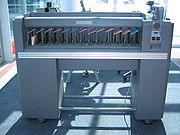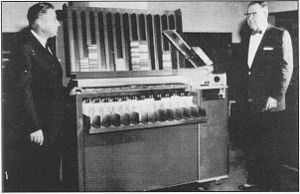
IBM 80 series Card Sorters
Encyclopedia

Earlier sorters
Original census sorter, 1890, manual.Sorting cards became an issue during the 1900 agricultural census, so Herman Hollerith
Herman Hollerith
Herman Hollerith was an American statistician who developed a mechanical tabulator based on punched cards to rapidly tabulate statistics from millions of pieces of data. He was the founder of one of the companies that later merged and became IBM.-Personal life:Hollerith was born in Buffalo, New...
developed the 1901 Hollerith Automatic Horizontal Sorter., a sorter with horizonal pockets.
In 1908, he designed the more compact Hollerith 070 Vertical Sorting Machine that sorted 250 cards per minute.
The IBM Type 71 Vertical Sorter came out in 1928. It had 12 pockets that could hold 80 cards. It could sort 150 cards per minute.
The IBM Type 75, Model 1, 19??, 400 cards per minute
The IBM Type 75, Model 2, 19??, 250 cards per minute
IBM 80 series Sorters

- IBM 80 Electric Punched Card Sorting Machine, model 1, Introduced by IBM in 1925, 450 cards per minute. This sorter was almost twice the speed of the older Hollerith 70 vertical sorter and used an entirely new magnetically operated horizontal design. At the close of 1943, IBM had 10,200 of these units on rental.
- IBM 80, model 2, 19??, 250 cards per minute
- IBM 81 Sorter, ????
- IBM 82 Sorter, 1949. Sorted cards at 650/minute
- IBM 83 Sorter, 19??. Sorted cards at 1000/minute
- IBM 84 Sorter, 19??. Sorted cards at 2000/minute
In August 1957, a basic 082 rented for $55 per month; an 083 for twice that.
Basic operation
The basic operation of a card sorter is to take a punched cardPunched card
A punched card, punch card, IBM card, or Hollerith card is a piece of stiff paper that contains digital information represented by the presence or absence of holes in predefined positions...
, examine a single column, and place the card into a selected pocket. There are twelve rows on a punched card, and thirteen pockets in the sorter; one sorter pocket is for blanks, rejects, and errors.
Cards are normally passed through the sorter face down with the bottom edge ("9-edge") first. A small metal brush or optical sensor is positioned so that, as each card goes through the sorter, one column passes under the brush or optical sensor. The holes sensed in that column together with the settings of the sorter controls determine pocket the card is to be directed to. This directing is done by slipping the card into a stack of metal strips (or chute blades) that run the length of the sorter feed mechanism. Each blade ends above one of the output pockets, and the card is thus routed to the designated pocket.
Sorting operations
Multiple column sorting was commonly done by first sorting the least significant column, then proceeding, column by column, to the most significant column. This is called a least significant digit radix sortRadix sort
In computer science, radix sort is a non-comparative integer sorting algorithm that sorts data with integer keys by grouping keys by the individual digits which share the same significant position and value...
.
Numeric columns have one punch in rows 0-9, possibly a sign overpunch in rows 11-12, and can be sorted in a single pass through the sorter. Alphabetic columns have a zone punch in rows 12, 11, or 0, a digit punch in one of the rows 1-9, and can be sorted by passing some or all of the cards through the sorter twice on that column. For more details of punched card codes see Punched card#IBM 80 column punched card format.
There were several methods used for Alphabetical sorting, depending on the features provided by the particular sorter and the characteristics of the data to be sorted. A commonly used method on the 082 and earlier sorters was to sort the cards twice on the same column, first on digit rows 1-9, then on the zone rows 12, 11, and 0 (or vice versa, zone rows first then digit rows). Operator switches allow zone-sorting by "switching off" rows 1-9 for the second pass of the card for each column.
Other special characters
Character (computing)
In computer and machine-based telecommunications terminology, a character is a unit of information that roughly corresponds to a grapheme, grapheme-like unit, or symbol, such as in an alphabet or syllabary in the written form of a natural language....
and punctuation marks were added to the card code
Code
A code is a rule for converting a piece of information into another form or representation , not necessarily of the same type....
, involving as many as three punches per column (and in 1964 with the introduction of EBCDIC
EBCDIC
Extended Binary Coded Decimal Interchange Code is an 8-bit character encoding used mainly on IBM mainframe and IBM midrange computer operating systems....
as many as six punches per column). The 083 and 084 sorters recognized these multiple digit or multiple zone punches, sorting them to the error pocket.
Further reading
- IBM Archives: IBM Type 80. Has descriptions, photos and rental prices.
External links
- Columbia University Computing History: IBM Card Sorters
- The Computer Collector: IBM Sorters (Models 75,80,82,83) Appears to be pages from the 1955 IBM Sales Manual.

